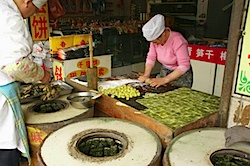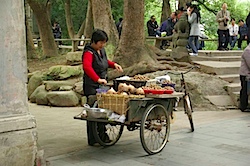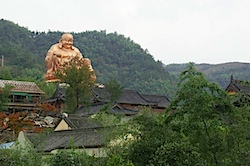I have reported of the elusive hills just outside campus before (here). This time I went into the opposite direction, i.e. southwest, to explore the hills further, to a place called Xikou. Xikou’s cultural significance comes from the fact that it is birth place of Chiang Kai-shek, who’s ancestral home has now been made into a tourist attraction.
It was a sunday and in the hope that we will have a nice relaxing and educational tour, we set off from Ningbo early in the morning only to arrive to in Xikou with thousands of other tourists. The place was absolutely heaving with people chasing their tour guides from one ‘scenic spot’ to the next; and the tour guides in turn were shouting into their megaphones to try and compete with the other ‘shouting megaphone tour guides’ … it wasn’t exactly relaxing shall we say. In fact is was one of those typical moments, of which there are comparatively many when in China, where you just wanted to turn around and leave, because you feel that it is just a little too surreal to deal with. Without such luck, we soldiered on and made the most of the beautiful views from Chiang’s balcony and garden area.
After visiting his home at the top of the hills, we ventured into the centre of the town … I am deliberately not reporting back about the restaurant and food we had for lunch (an experience best left forgotten) … where things had calmed down somewhat from all the excitement of the morning and where we had an enjoyable stroll along the main ‘tourist’ street. It was a great place to do some people watching, observe the street vendors selling local delicacies and be hypnotised by the slick, repetitive moves of the bakers making the area’s famous ‘thousand layer cake’. It it essentially a rice flour based ‘mille feuille’ or puff pastry, which is mixed with small quantities of seaweed powder, rolled in sesame seeds and then stuck to the inside of a wooden barrel, where it is baked through the means of a small wood fire at the bottom. Quite delicious when very hungry, in combination with tea of coffee or once you have got used to the subtle yet noticeable taste of seaweed (I’m sure it’s good for you!).
Â
Finally just a couple of shots from the area we visited in the morning. Despite the steep ticket price of 175RMB, which provided us access to all of the significant sites around Xikou, the one place that we couldn’t get access to was a huge, and I mean huge, temple complex with a gigantic (newly built … opened to the public only the day before) statue of a ‘Chinese’ Buddha. Apparently a Chinese Buddha is fatter, more smily and has bigger ear lobes than an Indian Buddha. This one was built to commemorate ‘some guy’ who said to his people: remember me in shape of a Buddha and that’s what his people came up with. You must excuse my ignorance regarding all the details of that story, which probably make it more exciting than it sounds the way I tell it, but the story our tour guide was telling us was somewhat drowned out by the exasperating voices of the other tour guides screaming monotonously into their megaphones.
Anyway, all in all it was a fun day out with new insights into Chinese tourism, Chinese history, Chinese culture and Chinese cuisine.
Â
Leave a Reply
You must be logged in to post a comment.





